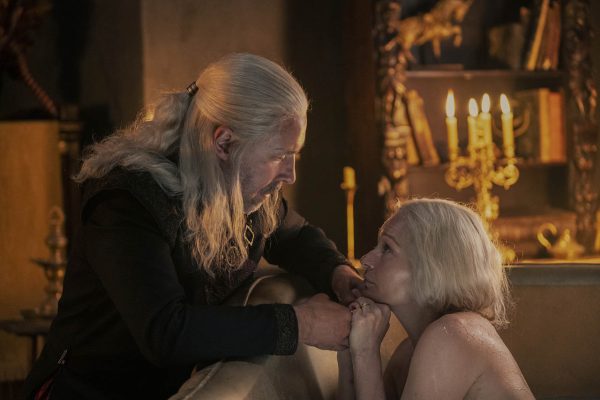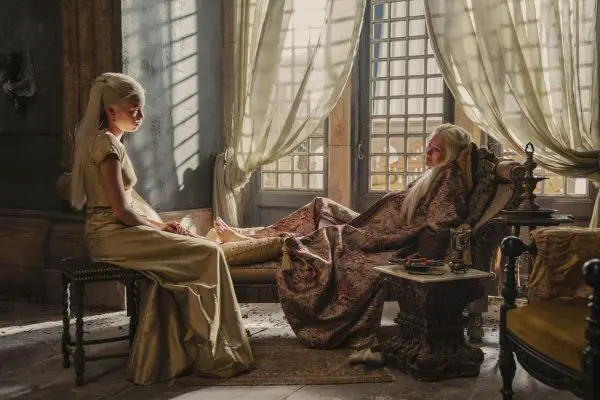
The prequel that was promised.
Three years after David Benioff and D.B Weiss’s adaptation of George RR Martin’s Song of Ice and Fire saga both rushed and tumbled over the finish line, Westeros has returned to our screens with a fiery vengeance in House of the Dragon, helmed by veteran Thrones director Miguel Sapochnik and writer Ryan J Condal. Set 172 years before the birth of the Mad King’s daughter, Daenerys Targaryen, House of the Dragon depicts the height of the Targaryen dynasty, enjoying a prosperous peace under the rule of Viserys I (Paddy Considine). After the premier’s prologue sets the context for Viserys’ rule (chosen over his female cousin Rhaenys (Eve Best) by his grandfather’s Great Council), The Heirs of the Dragon establishes the growing tensions between the silver-haired Dragonlords as Viserys hopes to solidify his line’s succession through the imminent birth of his child – one he “knows” will be a boy.

As Viserys and his wife Aemma (Sian Brooke) contemplate the arrival of their child, Heirs of the Dragon makes good work of establishing the other central players in the Targaryen household. Viserys’ first-born daughter Rhaenyra (Milly Alcock) – introduced in a magnificent opening sequence as she flies her golden dragon across the iconic King’s Landing – fosters a keen desire for adventure and escaping the drudgery of court life. Meanwhile, Viserys’ younger brother Daemon (Matt Smith) – introduced with him brazenly lurking on his brother’s throne, and subsequently the focus of the episode’s more violent and debauched sequences – displays not so much a childish cockiness but an ominous confidence in his ability to do – and say – what he wants. As he reminds Rhaenyra in their first meeting, until Viserys has a son, the family will be “cursed” with Daemon’s succession to the Iron Throne.
Just like the prime of Game of Thrones, Heirs of the Dragon takes its time to weave this complex tapestry of character relations, desires and insecurities, highlighting the bubbling tension that – if GRRM’s source material Fire and Blood will be adapted faithfully – will inevitably reach a boiling point by series’ end. Nowhere is this bubbling tension more apparent than in the Small Council scenes throughout the episode. Inheriting a peaceful dynasty, Viserys’ interactions with his supposed advisors are laced with a certain naivete that oftentimes misses the loaded comments and side glances that may signal his underlings’ more ambitious desires. Rhys Ifans’ Otto Hightower – Viserys’ Hand of the King – channels the calculating and austere gravitas of Tywin Lannister, while Corlys Velaryon (Steve Toussaint)’s misgivings over his wife Rhaenys’ denied ascent to the throne imbue a begrudging quality to his role as advisor to the impressionable king.
In a surprising but welcome development, the themes at the heart of House of the Dragon are established cleverly, and explored tastefully, in this opening episode. Throughout the hourlong runtime, the hypocrisies and injustices of Targaryen’s patriarchal rule permeate Viserys’ turmoil over his longing for a male heir. The two ‘battlefields’ of the Westerosi men and women are paralleled in the episode’s main set piece: a not-so-subtle jousting tournament, with petty duels and splatters of gore, is intercut with Aemma’s blood-ridden labor, her screams blending with the cheers of King’s Landing. It’s the most compelling visual sequence that the Game of Thrones ‘universe’ has achieved in several years, and underpins the thematic significance that Rhaenys, Rhaeneyra and her close friend Allicent Hightower (Emily Carey) will have as the series goes on, and the many assumed traditions of the Targaryen reign are challenged.

The first episodes of House of the Dragon have received comfortably-positive acclaim from critics; from first impressions I would be comfortable in saying the show’s core strengths will be the same as those that made its predecessor a success as well. At the height of its artistic and critical success, Game of Thrones was a highly compelling fantasy epic that enjoyed a host of well-developed, nuanced and flawed characters; rich dialogue sequences dripping in tension and political intrigue; and a peppering of well-crafted and visceral action set pieces. While the bombastic and still-impressive CG-heavy set pieces in the latter seasons assisted in lampshading the increasingly inexcusable lapses in narrative and thematic continuity, many fans have since expressed a longing for the older seasons (of which the broadest consensus will indicate Seasons 1-4, the period that had plenty of material to adapt and kept GRRM readily involved as Executive Producer).
If Heirs of the Dragon is anything to go by, this first-of-many planned spin-offs promises a much-welcome return to that golden era of Game of Thrones. It may be more of the same – similar families all vying for their claim to the same Iron Throne while Ramin Djawadi reprises all of the similar – and iconic – leitmotifs with all the appropriate orchestral gusto behind it. That is not a bad prospect by any means. The cast delivers a roundhouse of captivating performances: Paddy Considine and Matt Smith are especially notable in this episode. The former captures Viserys’ earnest compassion as much as his naivete; the latter chews the scenery while still finding moments to imbue an unmistakable vulnerability to Daemon’s outward confidence. The production values are second to none as the episode boasts very impressive – yet constrained – CG dragon spectacle, lavish sets, and equally decadent costumes. While the proficient cinematography and subdued color palette do evoke the aesthetic of the waning years of Thrones rather than the more dynamic visual vibrancy of earlier seasons, House of the Dragon remains a visual spectacle for television standards.
So far, House of the Dragon is reminding me what I loved about Game of Thrones, and as someone who is not intimately familiar with the Fire and Blood lore, the premier has done a surprisingly good job of avoiding the exposition-heavy dialogue of the latter half of Thrones while still being faithful to the tone and style of Martin’s expansive world.











![Wicked: For Good Is Up For Pre-order On Disc & Digital Including Collector’s & SteelBook Editions [Updated] Wicked for Good digital poster](https://hd-report.com/wp-content/uploads/2025/11/wicked-for-good-digital-poster-324x160.webp)
